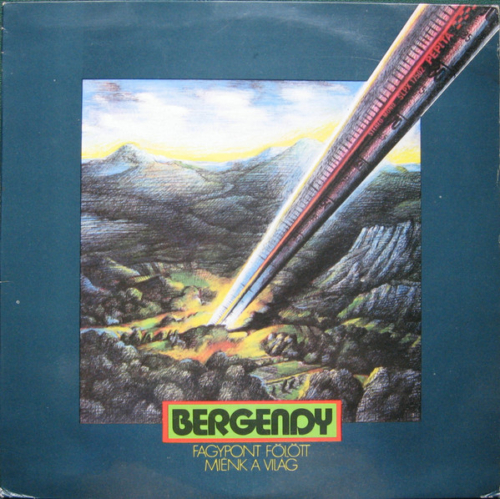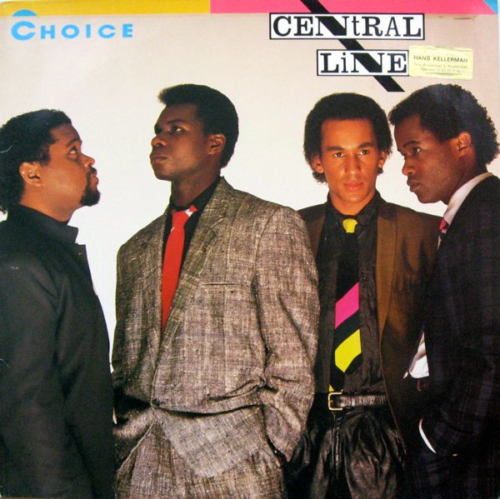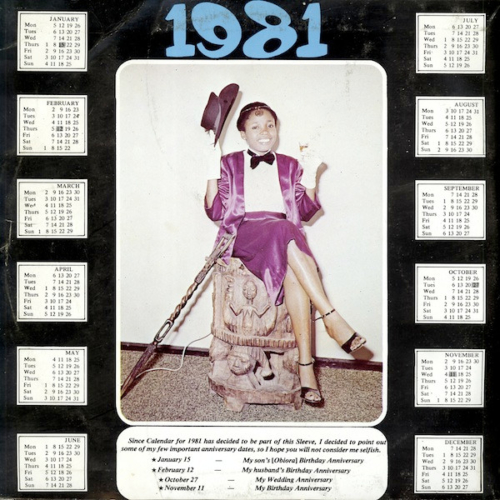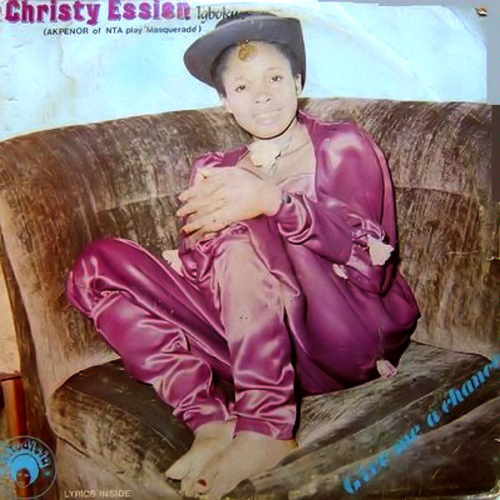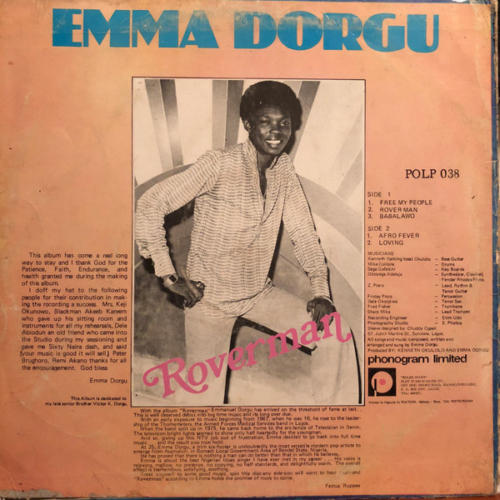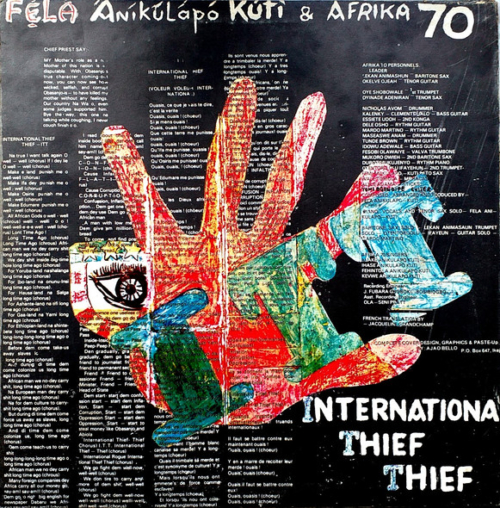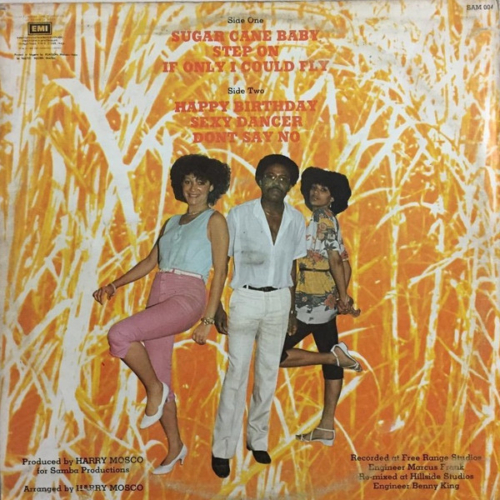-
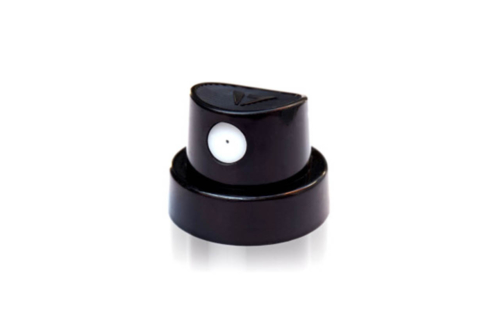 Der Klassiker! - das Loopcolors Original Cap - kompatibel mit fast allen Sprühdosen - normaler Output - für viele Einsatzbereiche geeignet Das schwarze Cap ist wohl den meisten unter Industrie Cap bekannt. Der serienmäßige Sprühkopf für normale Sprühstärken ist für fast jede Sprühdose geeignet. Ob Füllen, Outline oder besondere Details - mit dem Standard-Cap ist alles machbar. Das Standard Cap ist alt bewährt und der am häufigsten verwendete Sprühaufsatz. Es erzeugt einen relativ harten Strich bei Strichbreite vom 2-5cm. Die Strichstärke variiert außerdem je nach Entfernung von Sprühdose zum Objekt.
Der Klassiker! - das Loopcolors Original Cap - kompatibel mit fast allen Sprühdosen - normaler Output - für viele Einsatzbereiche geeignet Das schwarze Cap ist wohl den meisten unter Industrie Cap bekannt. Der serienmäßige Sprühkopf für normale Sprühstärken ist für fast jede Sprühdose geeignet. Ob Füllen, Outline oder besondere Details - mit dem Standard-Cap ist alles machbar. Das Standard Cap ist alt bewährt und der am häufigsten verwendete Sprühaufsatz. Es erzeugt einen relativ harten Strich bei Strichbreite vom 2-5cm. Die Strichstärke variiert außerdem je nach Entfernung von Sprühdose zum Objekt. -
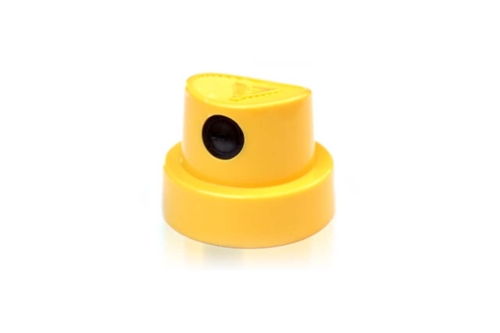 Höher, schneller, noch breiter! - das Loopcolors Super Fat Yellow Cap - kompatibel mit fast allen Sprühdosen - softer Output - flächiges Arbeiten - für viele Einsatzbereiche geeignet Das Super Fat Yellow Cap von Loopcolors ist ein klassisches Fat Cap mit maximiertem Output. Dieser Sprühkopf erzeugt sehr breite Linien bei einer Strichstärke zwischen 3-15cm. Die Strichstärke variiert außerdem je nach Entfernung von Sprühdose zum Objekt. Falls dir das klassische Pink Dot Fat Cap zu schmal und zu langsam sein sollte, ist das Loopcolors Super Fat Yellow Cap ideal für dich. Das Cap ermöglicht einen hohen Output und damit einen extrem schnellen und großflächigen Farbauftrag. Bei Nutzung dieses Sprühaufsatzes sollte beachtet werden, dass es durch den erhöhten Farbausstoß zu einem schnelleren Verbrauch der Sprühfarbe kommt.
Höher, schneller, noch breiter! - das Loopcolors Super Fat Yellow Cap - kompatibel mit fast allen Sprühdosen - softer Output - flächiges Arbeiten - für viele Einsatzbereiche geeignet Das Super Fat Yellow Cap von Loopcolors ist ein klassisches Fat Cap mit maximiertem Output. Dieser Sprühkopf erzeugt sehr breite Linien bei einer Strichstärke zwischen 3-15cm. Die Strichstärke variiert außerdem je nach Entfernung von Sprühdose zum Objekt. Falls dir das klassische Pink Dot Fat Cap zu schmal und zu langsam sein sollte, ist das Loopcolors Super Fat Yellow Cap ideal für dich. Das Cap ermöglicht einen hohen Output und damit einen extrem schnellen und großflächigen Farbauftrag. Bei Nutzung dieses Sprühaufsatzes sollte beachtet werden, dass es durch den erhöhten Farbausstoß zu einem schnelleren Verbrauch der Sprühfarbe kommt. -
 Lackmarker für extra breite Flächen - der UNI Paint Marker PX-30 - 4-8,5 mm Keilspitze - Wisch- und wasserfest - Geruchsarm - Schnelltrocknend und lichtbeständig - Chlor-, Schwefel-, Halogen- und Silikonfrei Mit diesem Permanent-Marker hast du das ideale Werkzeug für verschiedene Einsatzbereiche. Beschriften, Verzieren und Ausbessern gelingt im Handumdrehen. Der PX-30 ist mit seiner 4-8,5 mm Keilspitze besonders ideal für extra breite Areale geeignet und ist besonders gut für großflächige Farbaufträge einsetzbar. Er funktioniert auf diversen Untergründen wie Papier, Metall, Glas, Holz, Kunststoff, Leder oder Stein. Gefüllt ist der Marker mit einer brillianten, volldeckenden Farbtinte auf Ölbasis, welche wasserbeständig und lichtbeständig ist. Die Farbe wird über ein Pump-System in den sehr robusten Keilfilz geleitet, was ein sauberes Arbeiten garantiert. Den extrabreiten Uni Ball PX-30 Stift günstig kaufen. Mit dem Permanent-Marker ist Arbeiten in allen Bereich möglich: egal ob Graffiti, Deko oder Handwerk.
Lackmarker für extra breite Flächen - der UNI Paint Marker PX-30 - 4-8,5 mm Keilspitze - Wisch- und wasserfest - Geruchsarm - Schnelltrocknend und lichtbeständig - Chlor-, Schwefel-, Halogen- und Silikonfrei Mit diesem Permanent-Marker hast du das ideale Werkzeug für verschiedene Einsatzbereiche. Beschriften, Verzieren und Ausbessern gelingt im Handumdrehen. Der PX-30 ist mit seiner 4-8,5 mm Keilspitze besonders ideal für extra breite Areale geeignet und ist besonders gut für großflächige Farbaufträge einsetzbar. Er funktioniert auf diversen Untergründen wie Papier, Metall, Glas, Holz, Kunststoff, Leder oder Stein. Gefüllt ist der Marker mit einer brillianten, volldeckenden Farbtinte auf Ölbasis, welche wasserbeständig und lichtbeständig ist. Die Farbe wird über ein Pump-System in den sehr robusten Keilfilz geleitet, was ein sauberes Arbeiten garantiert. Den extrabreiten Uni Ball PX-30 Stift günstig kaufen. Mit dem Permanent-Marker ist Arbeiten in allen Bereich möglich: egal ob Graffiti, Deko oder Handwerk. -
Ausverkauft

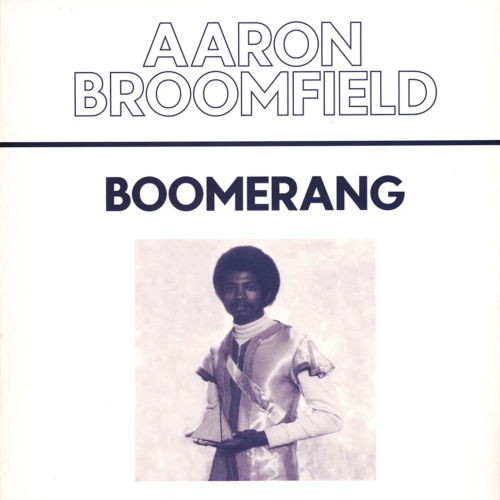 Crown Ruler Records returns with a slab of unreleased disco-funk from Miami musician, Aaron Broomfield. HEAVY tune, in two mixes.. TIP. “Boomerang” was first recorded in 1979, when the Broomfield Corporate Jam leader was attempting to plot a solo career. It was the first cut Aaron Broomfield recorded under his own name – Initially, at the family band’s home studio, Kilimanjaro, and later at professional studios in L.A and Miami – but it was never released. “I always wanted to be able to share ‘Boomerang’ with my fans some day – I didn’t release it back then because I thought the time wasn’t right,” Broomfield explains. “It was so different to what was considered commercial then and felt ahead of its time.” Before deciding against releasing it, Broomfield had two test pressings made. It was the accidental discovery of the one remaining record by digger Arun Brown (the other perished when Broomfield’s Kilimanjaro studio was damaged by a fire in 1996) that set in motion the chain of events that finally led to its release. The jacket boasts a written essay by Broomfield himself, telling the remarkable story behind the song. The wax features the two versions of Boomerang, of which both were meticulously restored and re-mastered by celebrated Australian sound engineer, Dan Elleson. Head to side A for the “test press” version, a cosmic, starry-eyed chunk of elastic Miami disco-funk where the Broomfield family’s killer instrumentation – all rubbery bass, deep space synths and crunchy Clavinet motifs – arcs around the sound space like a boomerang in flight. The vocal arrangement, in which Aaron Broomfield’s conscious lyrics come through loud and clear, brings it home. On the flipside, you’ll hear how dynamic the band was through the “Demo Version” - a relaxed, loose and spacey groover that sounds as ahead of its time in 2018 as it would have when it was recorded in 1979.
Crown Ruler Records returns with a slab of unreleased disco-funk from Miami musician, Aaron Broomfield. HEAVY tune, in two mixes.. TIP. “Boomerang” was first recorded in 1979, when the Broomfield Corporate Jam leader was attempting to plot a solo career. It was the first cut Aaron Broomfield recorded under his own name – Initially, at the family band’s home studio, Kilimanjaro, and later at professional studios in L.A and Miami – but it was never released. “I always wanted to be able to share ‘Boomerang’ with my fans some day – I didn’t release it back then because I thought the time wasn’t right,” Broomfield explains. “It was so different to what was considered commercial then and felt ahead of its time.” Before deciding against releasing it, Broomfield had two test pressings made. It was the accidental discovery of the one remaining record by digger Arun Brown (the other perished when Broomfield’s Kilimanjaro studio was damaged by a fire in 1996) that set in motion the chain of events that finally led to its release. The jacket boasts a written essay by Broomfield himself, telling the remarkable story behind the song. The wax features the two versions of Boomerang, of which both were meticulously restored and re-mastered by celebrated Australian sound engineer, Dan Elleson. Head to side A for the “test press” version, a cosmic, starry-eyed chunk of elastic Miami disco-funk where the Broomfield family’s killer instrumentation – all rubbery bass, deep space synths and crunchy Clavinet motifs – arcs around the sound space like a boomerang in flight. The vocal arrangement, in which Aaron Broomfield’s conscious lyrics come through loud and clear, brings it home. On the flipside, you’ll hear how dynamic the band was through the “Demo Version” - a relaxed, loose and spacey groover that sounds as ahead of its time in 2018 as it would have when it was recorded in 1979. -
Ausverkauft

 Used vinyl. Still in shrink. Played only 1-2 times. Kalita are excited to announce the first ever official reissue of Adelle First's highly sought-after 1986 12" South African boogie single 'Don't Give Up'!
Used vinyl. Still in shrink. Played only 1-2 times. Kalita are excited to announce the first ever official reissue of Adelle First's highly sought-after 1986 12" South African boogie single 'Don't Give Up'! -

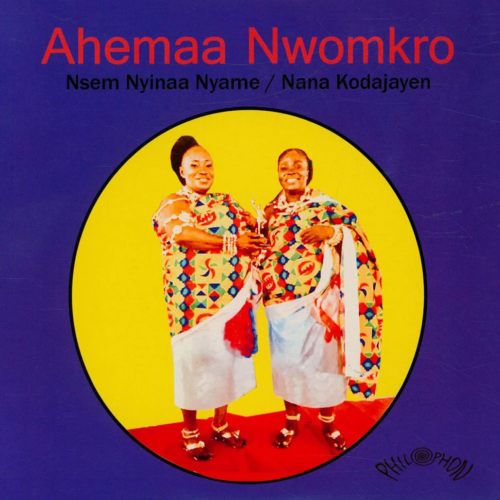 Ahemaa Nwomkro, which means queens of Nwomkro, are Victoria Osei and Theresa Owusuaa. Nwomkro is an old Ashanti musical style, which played an influential role in the origin of the typical more roots-like Highlife style of Kumasi, the cultural capital of Ghana in the middle of the jungle. On this release the two singers have teamed up with the young generation of Highlife muicians of Kumasi. On guitar is Akule Pepe, who served for years in the group of Highlife legend Alex Konadu, the most on demand band in its time. The two songs are a rare example of how good pure Nwomkro gets together with typical Highlife.
Ahemaa Nwomkro, which means queens of Nwomkro, are Victoria Osei and Theresa Owusuaa. Nwomkro is an old Ashanti musical style, which played an influential role in the origin of the typical more roots-like Highlife style of Kumasi, the cultural capital of Ghana in the middle of the jungle. On this release the two singers have teamed up with the young generation of Highlife muicians of Kumasi. On guitar is Akule Pepe, who served for years in the group of Highlife legend Alex Konadu, the most on demand band in its time. The two songs are a rare example of how good pure Nwomkro gets together with typical Highlife. -
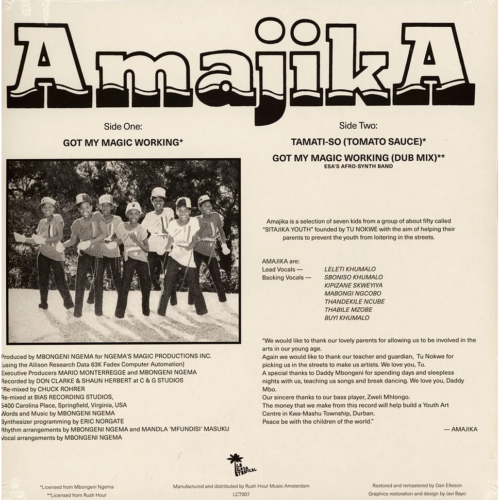
 Heavy South African cut, unearthed by Dene from LCT, All about the massive title track ''Got My Magic Working''... Phat bassline, machinegun claps dipped in acid! The origins of Amajika is a tale of two worlds colliding at the perfect moment and begin in KwaMushu Township outside Durban. Here would be where a young Tu Nokwe would set up a school to help teach other aspiring youngsters like herself in music, dance and acting. This would become known as the Amajika Youth and Children’s Art Project and would be run from the Nokwe home, a common hangout for artists at the time. Some boast 2000+ pupils going through this program while others claim it wasn’t more than a backyard dance group, but for the lucky group of kids that were members in the mid 80s it would be their chance at stardom. It was during these years that a young aspiring playwright and musician Mbongeni Ngema had come across Tu and her group of gifted youngsters at the Nokwe family home. Although he was touring extensively at the time with the plays Woza Albert and Asinamali, the latter which eventually ended up on broadway, he would spend any time off from the tour with Tu and her dance troop. After being inspired by the American group New Edition, Mbongeni envisioned Amajika as the South African answer and decided to bankroll a studio session. The session would take place in a private studio in Durban.The release of the first single would follow very shortly. The lead track, Tomati-So is a fun swinging groove over some basic programmed drums. The song is dedicated to Tu Nokwe sings of her unique style and kind heart. On his next tour Mbongeni would take the remaining masters with him to the US and had the track remixed. Although it never materialized in a release States side he did return with the remixed tape and release it in South Africa the following year. Much like Tomato So the song was an ode and would be dedicated to the man who was making all their dreams come true. Got My Magic Working sings of going overseas and being a star on Broadway and TV and the man who is making it all happen. All these true predictions are sung on top of a groovy acid bass by a clearly matured troop of artists. During these years of working with Amajika, Mbongeni became very impressed with the exceeding talent of one of the members and decided to cast her in his upcoming musical Sarafina. The other children also wanted to be a part of the Broadway show but not everyone would get a role. This would be the end of Amajika as the next years would be dedicated to creating success on the musical stage. The growing kids that formed Amajika became young adults and pursued their own careers after the fact. Tu Nokwe would leave the country to return years later as the wife of Shaka Zulu on the big screen. To this day she is still very active both on stage and screen while Mbongeni is still writing and adding to the South African Musical Theatre catalog. Fast forward 30 years from the original release to a smokey club where ESA hears Got My Magic Working played by Rush Hours Store’s own Bonnefooi. Instantly he inquires about the track from his homeland and feels it a perfect addition the repertoire of the Afro Synth band he is quietly cooking up. The band’s instrumental take ended up as the B side on a mysterious and limited white label released by Rush Hour in early 2020 but quickly sold out. Here you have compiled the two title tracks from original Amajika singles along with the instrumental version by ESA’s Afro Synth Band for The complete Amajika experience, past to present.
Heavy South African cut, unearthed by Dene from LCT, All about the massive title track ''Got My Magic Working''... Phat bassline, machinegun claps dipped in acid! The origins of Amajika is a tale of two worlds colliding at the perfect moment and begin in KwaMushu Township outside Durban. Here would be where a young Tu Nokwe would set up a school to help teach other aspiring youngsters like herself in music, dance and acting. This would become known as the Amajika Youth and Children’s Art Project and would be run from the Nokwe home, a common hangout for artists at the time. Some boast 2000+ pupils going through this program while others claim it wasn’t more than a backyard dance group, but for the lucky group of kids that were members in the mid 80s it would be their chance at stardom. It was during these years that a young aspiring playwright and musician Mbongeni Ngema had come across Tu and her group of gifted youngsters at the Nokwe family home. Although he was touring extensively at the time with the plays Woza Albert and Asinamali, the latter which eventually ended up on broadway, he would spend any time off from the tour with Tu and her dance troop. After being inspired by the American group New Edition, Mbongeni envisioned Amajika as the South African answer and decided to bankroll a studio session. The session would take place in a private studio in Durban.The release of the first single would follow very shortly. The lead track, Tomati-So is a fun swinging groove over some basic programmed drums. The song is dedicated to Tu Nokwe sings of her unique style and kind heart. On his next tour Mbongeni would take the remaining masters with him to the US and had the track remixed. Although it never materialized in a release States side he did return with the remixed tape and release it in South Africa the following year. Much like Tomato So the song was an ode and would be dedicated to the man who was making all their dreams come true. Got My Magic Working sings of going overseas and being a star on Broadway and TV and the man who is making it all happen. All these true predictions are sung on top of a groovy acid bass by a clearly matured troop of artists. During these years of working with Amajika, Mbongeni became very impressed with the exceeding talent of one of the members and decided to cast her in his upcoming musical Sarafina. The other children also wanted to be a part of the Broadway show but not everyone would get a role. This would be the end of Amajika as the next years would be dedicated to creating success on the musical stage. The growing kids that formed Amajika became young adults and pursued their own careers after the fact. Tu Nokwe would leave the country to return years later as the wife of Shaka Zulu on the big screen. To this day she is still very active both on stage and screen while Mbongeni is still writing and adding to the South African Musical Theatre catalog. Fast forward 30 years from the original release to a smokey club where ESA hears Got My Magic Working played by Rush Hours Store’s own Bonnefooi. Instantly he inquires about the track from his homeland and feels it a perfect addition the repertoire of the Afro Synth band he is quietly cooking up. The band’s instrumental take ended up as the B side on a mysterious and limited white label released by Rush Hour in early 2020 but quickly sold out. Here you have compiled the two title tracks from original Amajika singles along with the instrumental version by ESA’s Afro Synth Band for The complete Amajika experience, past to present. -
Ausverkauft

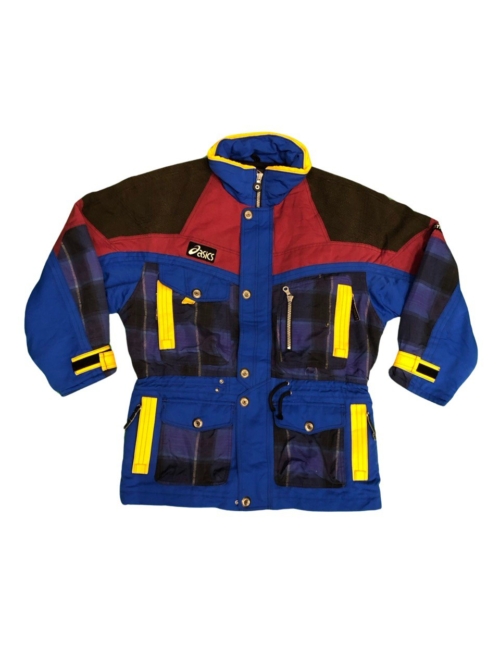 Bunte 80er/90er Asics Skijacke in einwandfreiem Zustand. Viele Taschen! Die genaue Größe ist leider nicht zu sehen - entspricht aber eher einer M.
Bunte 80er/90er Asics Skijacke in einwandfreiem Zustand. Viele Taschen! Die genaue Größe ist leider nicht zu sehen - entspricht aber eher einer M. -

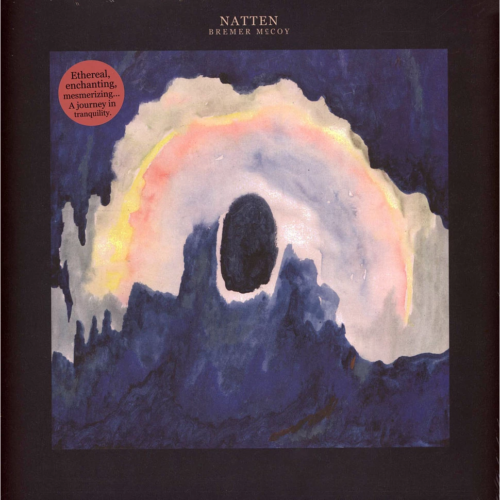 What were they up to? Nobody could tell—not even them. Bremer/McCoy recorded straight to tape so that they had as little time as possible to think about it. They just laid it down. They couldn’t really explain it. “When it works for me,” says pianist Morten McCoy, “it’s pure meditation, pure prayer. Pure gratitude for simply being, without all kinds of jibber-jabber filling my thoughts.” A sentiment that tells you everything about the feeling and nothing about the sound. McCoy and the bassist Jonathan Bremer started making music together back in 2012 when they were still in school. At first the Danish duo played dub. It’s hard to imagine that that’s how they started when you listen to the ethereal sounds they make now, but the influence becomes clearer when you see them live: they insist on traveling with their own sound system. For Bremer/McCoy, making music is all about what happens in the room. That’s why they go through the trouble of carrying their own equipment, and it’s why they record analog. When they write music, they aim for direct transmission—idea straight to composition. Natten, which means “The Night” in Danish, draws inspiration from the end of day, that regenerative time under the constellations when our lives look different. “We felt a greater freedom this time around because we now have a much deeper understanding and grounding in what we’re doing,” says Bremer. “This allows us to venture further out than ever before, because we know that things typically fall into place.”
What were they up to? Nobody could tell—not even them. Bremer/McCoy recorded straight to tape so that they had as little time as possible to think about it. They just laid it down. They couldn’t really explain it. “When it works for me,” says pianist Morten McCoy, “it’s pure meditation, pure prayer. Pure gratitude for simply being, without all kinds of jibber-jabber filling my thoughts.” A sentiment that tells you everything about the feeling and nothing about the sound. McCoy and the bassist Jonathan Bremer started making music together back in 2012 when they were still in school. At first the Danish duo played dub. It’s hard to imagine that that’s how they started when you listen to the ethereal sounds they make now, but the influence becomes clearer when you see them live: they insist on traveling with their own sound system. For Bremer/McCoy, making music is all about what happens in the room. That’s why they go through the trouble of carrying their own equipment, and it’s why they record analog. When they write music, they aim for direct transmission—idea straight to composition. Natten, which means “The Night” in Danish, draws inspiration from the end of day, that regenerative time under the constellations when our lives look different. “We felt a greater freedom this time around because we now have a much deeper understanding and grounding in what we’re doing,” says Bremer. “This allows us to venture further out than ever before, because we know that things typically fall into place.” -
Ausverkauft

 Original Browns Jacke von Starter. Einwandfreier Zustand. Größe L.
Original Browns Jacke von Starter. Einwandfreier Zustand. Größe L. -
Ausverkauft

 Ein feiner Zwirn von Carlo Colucci, der wahrscheinlich noch der etwas älteren Generation angehört. Zum größten Teil schwarz, an den Ärmeln jedoch mit schönen Stickmustern verziert. Carlo Colucci - When personality becomes style. Größe 50.
Ein feiner Zwirn von Carlo Colucci, der wahrscheinlich noch der etwas älteren Generation angehört. Zum größten Teil schwarz, an den Ärmeln jedoch mit schönen Stickmustern verziert. Carlo Colucci - When personality becomes style. Größe 50. -
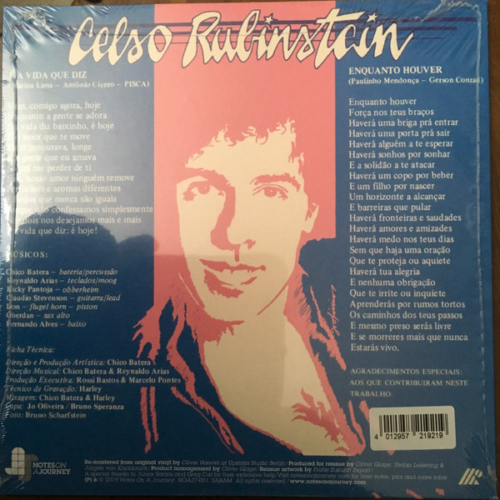
 Great brazilian tunes on this 7'' double sider!! Born in Brazil to a family of Holocaust survivors, Celso Rubinstein’s career as a singer allowed him to take residency in several countries including Spain, Portugal, Israel and Britain. He performed as an artist in numerous clubs and supported other artists as backing vocalist. In 1982 he booked studio time at Chico Batera’s studio in Rio De Janeiro to record two songs for an intentional debut album. On «Enquanto Houver», written by Paulinho Mendonça and Gerson Conrad, Rubinstein tried to infuse some rap flavour: «I wanted to get away from that style of singing where you sing a bunch of notes without breathing. You can hear that all the words in the song are pronounced properly but the cadence is broken up, so the intention was to do a kind of rap without it seeming to be rap. Used vinyl (only played 1-2 times in our store) VG+/ NM (still in shrink)
Great brazilian tunes on this 7'' double sider!! Born in Brazil to a family of Holocaust survivors, Celso Rubinstein’s career as a singer allowed him to take residency in several countries including Spain, Portugal, Israel and Britain. He performed as an artist in numerous clubs and supported other artists as backing vocalist. In 1982 he booked studio time at Chico Batera’s studio in Rio De Janeiro to record two songs for an intentional debut album. On «Enquanto Houver», written by Paulinho Mendonça and Gerson Conrad, Rubinstein tried to infuse some rap flavour: «I wanted to get away from that style of singing where you sing a bunch of notes without breathing. You can hear that all the words in the song are pronounced properly but the cadence is broken up, so the intention was to do a kind of rap without it seeming to be rap. Used vinyl (only played 1-2 times in our store) VG+/ NM (still in shrink) -
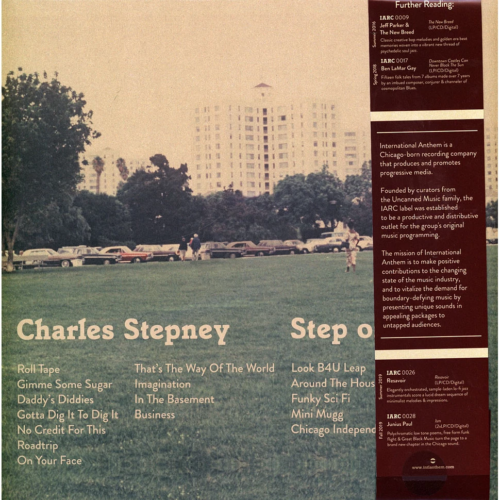
 Chicago-born composer, producer and arranger Charles Stepney is known to some for his work with Earth, Wind & Fire, Deniece Williams, and Ramsey Lewis, or for his work with Chess Records in the 1960s, where he was an essential creative force behind seminal recordings by Rotary Connection, Minnie Riperton, Marlena Shaw, Muddy Waters, Howlin Wolf, Terry Callier, The Dells, The Emotions, and many many more. In the decades since his untimely death in 1976, the presence of his name in liner notes and on vinyl labels has become a seal of quality for record collectors, music historians, and aficionados, while his sound has been used by countless samplers in the hip-hop world including Kanye West, A Tribe Called Quest, The Fugees, MF Doom, and Madlib. But in comparison to the post-mortem renown of his sound, or the music he created and the artists he supported while he was alive, Stepney is a greatly under-appreciated figure... a genius relegated to the shadows.
Chicago-born composer, producer and arranger Charles Stepney is known to some for his work with Earth, Wind & Fire, Deniece Williams, and Ramsey Lewis, or for his work with Chess Records in the 1960s, where he was an essential creative force behind seminal recordings by Rotary Connection, Minnie Riperton, Marlena Shaw, Muddy Waters, Howlin Wolf, Terry Callier, The Dells, The Emotions, and many many more. In the decades since his untimely death in 1976, the presence of his name in liner notes and on vinyl labels has become a seal of quality for record collectors, music historians, and aficionados, while his sound has been used by countless samplers in the hip-hop world including Kanye West, A Tribe Called Quest, The Fugees, MF Doom, and Madlib. But in comparison to the post-mortem renown of his sound, or the music he created and the artists he supported while he was alive, Stepney is a greatly under-appreciated figure... a genius relegated to the shadows. -
Ausverkauft
 Grauer Hoodie von Chevignon. Sehr guter Zustand. Größe: L.
Grauer Hoodie von Chevignon. Sehr guter Zustand. Größe: L. -
Ausverkauft

 Sehr dopes Chicago White Sox Baseball Trikot von der Kult-Marke Starter. Auf dem Rücken steht die Nummer 8 und der Name Belle - gemeint ist der Baseball Profi Albert Belle. Super Zustand. Größe: Es steht zwar M drauf, fällt aber eher wie eine L aus.
Sehr dopes Chicago White Sox Baseball Trikot von der Kult-Marke Starter. Auf dem Rücken steht die Nummer 8 und der Name Belle - gemeint ist der Baseball Profi Albert Belle. Super Zustand. Größe: Es steht zwar M drauf, fällt aber eher wie eine L aus. -
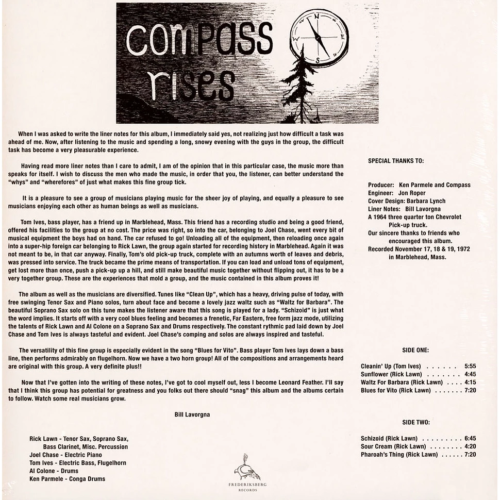
 When arists self-releases their own recordings, they do so in the hopes that a hit might develop, or even better, a sphere of influence might form. In a lot of cases these records provide a stamp of existence and intent – a sonic business card showing what musicians were made of. Compass Rises (1973), the privately pressed sole LP by Oneonta, New York’s Compass, is both a sampling of versatility and a declaration of straight-ahead purpose. Regularly active in upstate New York between 1969 and 1974, Compass was an acoustic-electric quartet that played original music and modern jazz standards. The group consisted of saxophonist and bass clarinetist Rick Lawn, keyboardist Joel Chase, bassist Tom Ives (doubling on flugelhorn), and drummer Al Colone. On the LP, percussion duties were shared across the band as well as an conguero, Ken Parmele. Every song on Compass Rises, with the exception of the opener, is written and arranged by Lawn. The album is a nod to the post-Coltrane lineage of 1970’s jazz – even at its most spry there’s an undertow of workmanlike toughness, perhaps a reflection of the industrial-collegiate hybrid towns in New York where Compass plied their trade. Ives’ “Cleanin’ Up” starts the proceedings, a modal groover that would not have sounded out of place on a Joe Henderson Milestone LP, coupled with a neat, funky turnaround in the head. “Sunflower” has a slight Latin flavor and while it’s not exactly Freddie Hubbard’s “Little Sunflower,” it does have a lilt that’s both sinewy and breezy, with Lawn’s huskily burnished tenor shimmying atop. Following the ballad “Waltz for Barbara,” a front line expanded with Ives’ flugelhorn opens up on the driving “Blues for Vito,” dry and cracking rhythm supporting a tough, metallic dance. Side two begins with “Schizoid,” the nasally incision of Lawn’s soprano saxophone in spiraling turns against pummeling toms and Chase’s fuzzed-out intervallic sprawl. “Sour Cream” is a choppy bit of soul jazz, while the closing “Pharoah’s Thing” starts off on an elegiac plateau before unfurling with a piquant, minor-key bounce. With its stark, somewhat gothic cover art and toothy, inspired playing and composing, Compass Rises deserves the critical examination that it likely didn’t have upon release.
When arists self-releases their own recordings, they do so in the hopes that a hit might develop, or even better, a sphere of influence might form. In a lot of cases these records provide a stamp of existence and intent – a sonic business card showing what musicians were made of. Compass Rises (1973), the privately pressed sole LP by Oneonta, New York’s Compass, is both a sampling of versatility and a declaration of straight-ahead purpose. Regularly active in upstate New York between 1969 and 1974, Compass was an acoustic-electric quartet that played original music and modern jazz standards. The group consisted of saxophonist and bass clarinetist Rick Lawn, keyboardist Joel Chase, bassist Tom Ives (doubling on flugelhorn), and drummer Al Colone. On the LP, percussion duties were shared across the band as well as an conguero, Ken Parmele. Every song on Compass Rises, with the exception of the opener, is written and arranged by Lawn. The album is a nod to the post-Coltrane lineage of 1970’s jazz – even at its most spry there’s an undertow of workmanlike toughness, perhaps a reflection of the industrial-collegiate hybrid towns in New York where Compass plied their trade. Ives’ “Cleanin’ Up” starts the proceedings, a modal groover that would not have sounded out of place on a Joe Henderson Milestone LP, coupled with a neat, funky turnaround in the head. “Sunflower” has a slight Latin flavor and while it’s not exactly Freddie Hubbard’s “Little Sunflower,” it does have a lilt that’s both sinewy and breezy, with Lawn’s huskily burnished tenor shimmying atop. Following the ballad “Waltz for Barbara,” a front line expanded with Ives’ flugelhorn opens up on the driving “Blues for Vito,” dry and cracking rhythm supporting a tough, metallic dance. Side two begins with “Schizoid,” the nasally incision of Lawn’s soprano saxophone in spiraling turns against pummeling toms and Chase’s fuzzed-out intervallic sprawl. “Sour Cream” is a choppy bit of soul jazz, while the closing “Pharoah’s Thing” starts off on an elegiac plateau before unfurling with a piquant, minor-key bounce. With its stark, somewhat gothic cover art and toothy, inspired playing and composing, Compass Rises deserves the critical examination that it likely didn’t have upon release. -
Ausverkauft
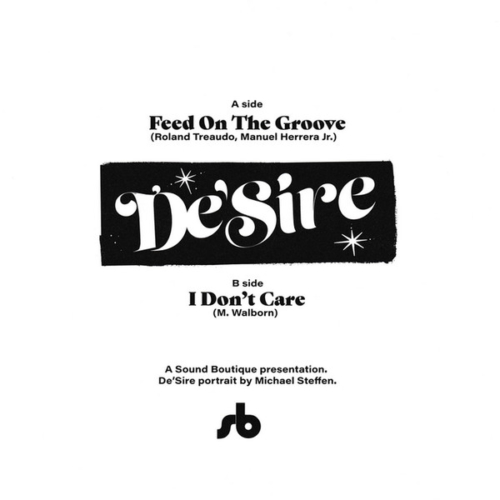
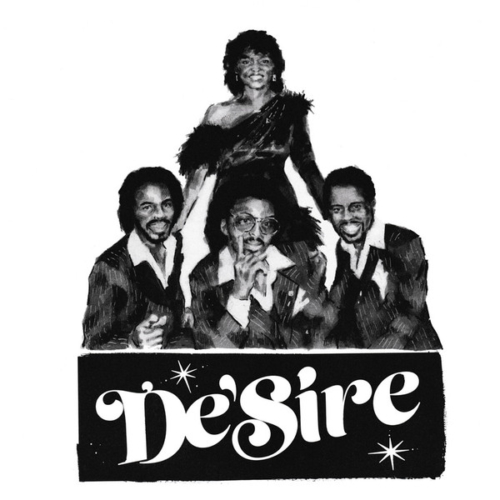 Killer boogie cuts from 1984 reissues! Double sider... 300 limited, grab it..
Killer boogie cuts from 1984 reissues! Double sider... 300 limited, grab it.. -
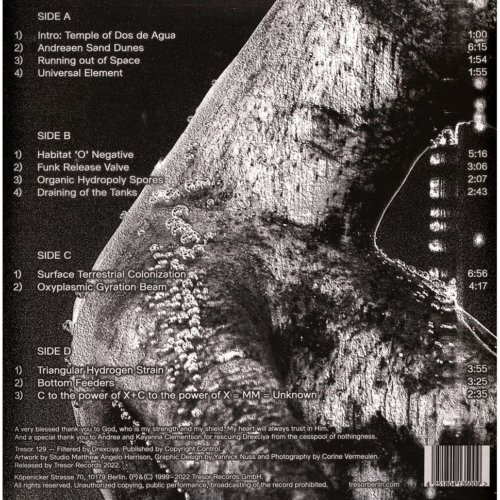
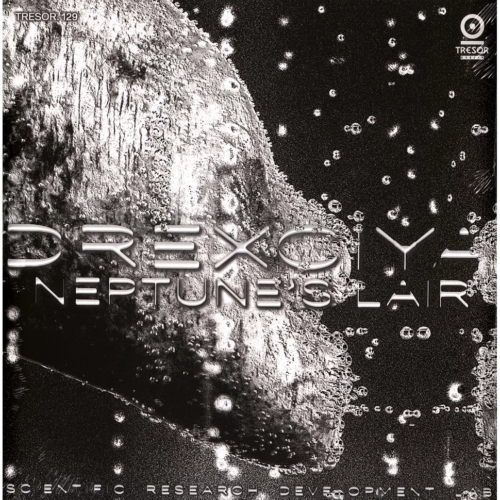 Tresor Records announces forthcoming special editions of its entire catalogue of Drexciya and related projects. 2022 marks the 20th anniversary of the passing of James Stinson and the releases of the Transllusion and Shifted Phases albums. In recognition, the rightsholders, their families, and the label have commissioned Detroit-based contemporary artist Matthew Angelo Harrison to re-conceptualize the covers of Tresor's Drexciya-related catalogue. These editions will be released sequentially, bimonthly, starting early-September 2022. The series starts with Neptune's Lair, first released in 1999, with the Hydro Doorways single arriving shortly after. In November, Harnessed The Storm and Digital Tsunami are coming. In 2023 comes the release of Transllusion in February. The series is completed by the long-awaited re-release of Shifted Phases - The Cosmic Memoirs Of The Late Great Rupert J. Rosinthrope - at the end of March. These records, individually and as a catalogue, represent some of the most crucial moments in the Tresor label history, with the sound and mythic world of Drexciya undoubtedly inspiring generations.
Tresor Records announces forthcoming special editions of its entire catalogue of Drexciya and related projects. 2022 marks the 20th anniversary of the passing of James Stinson and the releases of the Transllusion and Shifted Phases albums. In recognition, the rightsholders, their families, and the label have commissioned Detroit-based contemporary artist Matthew Angelo Harrison to re-conceptualize the covers of Tresor's Drexciya-related catalogue. These editions will be released sequentially, bimonthly, starting early-September 2022. The series starts with Neptune's Lair, first released in 1999, with the Hydro Doorways single arriving shortly after. In November, Harnessed The Storm and Digital Tsunami are coming. In 2023 comes the release of Transllusion in February. The series is completed by the long-awaited re-release of Shifted Phases - The Cosmic Memoirs Of The Late Great Rupert J. Rosinthrope - at the end of March. These records, individually and as a catalogue, represent some of the most crucial moments in the Tresor label history, with the sound and mythic world of Drexciya undoubtedly inspiring generations. -
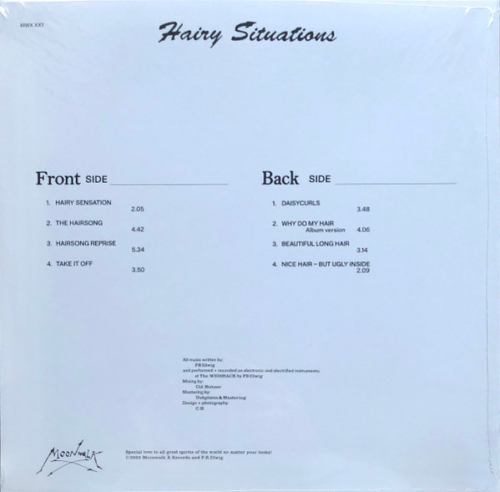
 „One day I was on a visit sitting in his kitchen and when we decided to change to the sofa in the music room, his girlfriend proposed to listen to these old recordings, as maybe I would be weird enough to like them. „Recorded in my homestudio, low budget style with a cheap microphone, a sampler, drum machines, vinyl and a few borrowed synths. … A commitment to the funk, a raw analogue sound and also a dedication to black music and its architects.“ the artist comments on it. I immediately dug the rather short demos a lot. As I had to swallow the information that there never were real plans to release them, I later decided on the bus home, I just had to puke out a „label“. Soon I asked him to extend some of the songs and let me do some mixing and here is the album.“ (Cid Hohner) An entire long-player on hair, representing the complete Illwig catalogue. Beautifully raw electronic funk. Obscure, bouncy and atmospheric. Right. This is F.B.Illwig with the first official release on Moonwalk X Records after a singlesided promo 12“ sporting the extended version of „Why Do My Hair“.
„One day I was on a visit sitting in his kitchen and when we decided to change to the sofa in the music room, his girlfriend proposed to listen to these old recordings, as maybe I would be weird enough to like them. „Recorded in my homestudio, low budget style with a cheap microphone, a sampler, drum machines, vinyl and a few borrowed synths. … A commitment to the funk, a raw analogue sound and also a dedication to black music and its architects.“ the artist comments on it. I immediately dug the rather short demos a lot. As I had to swallow the information that there never were real plans to release them, I later decided on the bus home, I just had to puke out a „label“. Soon I asked him to extend some of the songs and let me do some mixing and here is the album.“ (Cid Hohner) An entire long-player on hair, representing the complete Illwig catalogue. Beautifully raw electronic funk. Obscure, bouncy and atmospheric. Right. This is F.B.Illwig with the first official release on Moonwalk X Records after a singlesided promo 12“ sporting the extended version of „Why Do My Hair“. -
 After her surprise debut "Mam Pe'ela Su'ure", Ghana's Frafra gospel queen Florence Adooni is back with her second single on Philophon. Born as Frafra in Kumasi, the capital of the Ashanti, she combines the best of both cultures into a unique fusion. The meandering, mostly pentatonic melodies of the Frafra glide over the high-life rhythm of the Ashanti with incredible ease. "Yinne" means The Creator and is one of the songs sung at the culmination of the Sunday service. Its driving rhythm usually guarantees a collective ecstasy in the community. "Fo Yelle", on the other hand, has more of a meditative effect on the listener. Its rather solemn rhythm leads you into tranquility and opens your soul to receive the divine spark. The songs were produced by Max Weissenfeldt in Kumasi/Ghana.
After her surprise debut "Mam Pe'ela Su'ure", Ghana's Frafra gospel queen Florence Adooni is back with her second single on Philophon. Born as Frafra in Kumasi, the capital of the Ashanti, she combines the best of both cultures into a unique fusion. The meandering, mostly pentatonic melodies of the Frafra glide over the high-life rhythm of the Ashanti with incredible ease. "Yinne" means The Creator and is one of the songs sung at the culmination of the Sunday service. Its driving rhythm usually guarantees a collective ecstasy in the community. "Fo Yelle", on the other hand, has more of a meditative effect on the listener. Its rather solemn rhythm leads you into tranquility and opens your soul to receive the divine spark. The songs were produced by Max Weissenfeldt in Kumasi/Ghana. -
Ausverkauft

 Used vinyl. VG+/VG+
Used vinyl. VG+/VG+ -
Ausverkauft

 Official LP reissue of 'Peace & Harmony' by Nigerian funk royalty Harry Mosco, Originally released in 1979. Incl the big tracks ''Sexy Dancer'', ''Step On'' and ''Do It Together'' Isle Of Jura digs deep going back 40 years for the reissue of Harry's 1979 album which is something of an undiscovered gem that touches upon Disco, Funk, Boogie, Soul and Dub. Harry passed away in 2012 and we’ve worked closely with his son on the reissue. Harry Mosco is best known as the founder of legendary 1970s Nigerian Afro-Funk band The Funkees. Originating as an Army band after the Nigerian Civil War they lead the wave of upbeat music produced by young artists in Nigeria in response to the darkness of the recently concluded civil conflict. Following a notable hit single ‘Akula Owu Onyeara’ the band split in 1977 and Harry pursued a solo career. ‘Peace & Harmony’ was Harry’s third LP continuing the rich vein of form found in previous albums ‘Country Boy’ and ‘Funkees’ (For You Specially). He was a visionary who wrote, arranged and produced each song on the LP assisted by Mark Lusari on engineering duties (P.I.L, Jah Wobble & Prince I), whose Reggae and Dub influence can be felt on title track ‘Peace & Harmony’ and ‘Peaceful Dub’. The LP contains two certified floorfillers of Studio 54 era Disco Funk in the shape of ‘Sexy Dancer’ & ‘Step On’ and two slow jams, the soulful ballad ‘She’s Gone’ and horn lead album closer ‘Do It Together’. Mr Funkees was printed on the cover to help record buyers make the connection between Mosco and his former band.
Official LP reissue of 'Peace & Harmony' by Nigerian funk royalty Harry Mosco, Originally released in 1979. Incl the big tracks ''Sexy Dancer'', ''Step On'' and ''Do It Together'' Isle Of Jura digs deep going back 40 years for the reissue of Harry's 1979 album which is something of an undiscovered gem that touches upon Disco, Funk, Boogie, Soul and Dub. Harry passed away in 2012 and we’ve worked closely with his son on the reissue. Harry Mosco is best known as the founder of legendary 1970s Nigerian Afro-Funk band The Funkees. Originating as an Army band after the Nigerian Civil War they lead the wave of upbeat music produced by young artists in Nigeria in response to the darkness of the recently concluded civil conflict. Following a notable hit single ‘Akula Owu Onyeara’ the band split in 1977 and Harry pursued a solo career. ‘Peace & Harmony’ was Harry’s third LP continuing the rich vein of form found in previous albums ‘Country Boy’ and ‘Funkees’ (For You Specially). He was a visionary who wrote, arranged and produced each song on the LP assisted by Mark Lusari on engineering duties (P.I.L, Jah Wobble & Prince I), whose Reggae and Dub influence can be felt on title track ‘Peace & Harmony’ and ‘Peaceful Dub’. The LP contains two certified floorfillers of Studio 54 era Disco Funk in the shape of ‘Sexy Dancer’ & ‘Step On’ and two slow jams, the soulful ballad ‘She’s Gone’ and horn lead album closer ‘Do It Together’. Mr Funkees was printed on the cover to help record buyers make the connection between Mosco and his former band.


